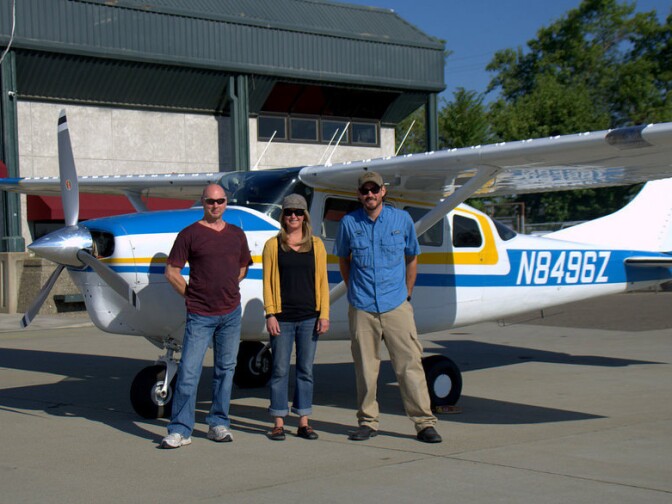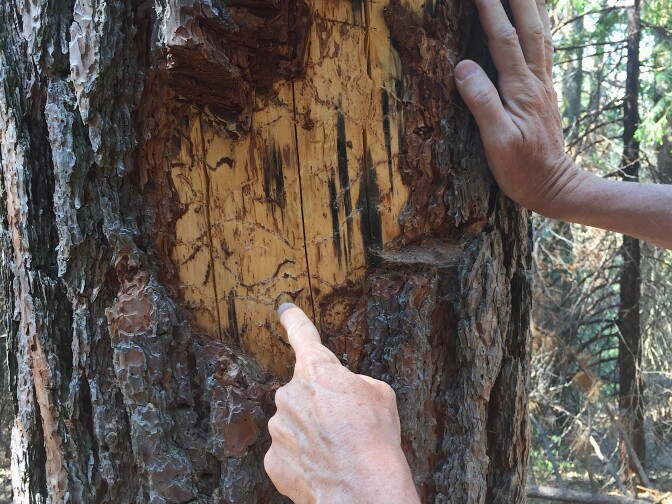With our free press under threat and federal funding for public media gone, your support matters more than ever. Help keep the LAist newsroom strong, become a monthly member or increase your support today.
Scientists offer front-lines look at California's tree mortality epidemic
Nate Stephenson got into forest ecology because he was looking for an excuse to go backpacking. He started out as a volunteer in Sequoia and Kings Canyon National Park in 1979. Now he’s a research ecologist for the U.S. Geological Survey, based at the park’s headquarters. He doesn’t even leave for vacation: he takes backpacking trips in the High Sierra.
“I’m just passionately in love with the Sierra Nevada. It’s my center of the universe," he said.
In 2014, Stephenson started noticing that oaks were dying in the foothills around Three Rivers, where he lives with his wife. He’d never seen that before – and he would notice, because he is always on the lookout for dead trees.
“When suddenly you’re seeing two, three, four times more dead trees than you’ve ever seen at once, it really wakes you up, hits you in the face.”
Stephenson was witnessing the beginning of an unprecedented, drought-fueled die-off. The U.S. Forest Service estimates over 100 million trees have died in California since 2010. This year alone, they counted 62 million dead trees. Normally they see about 1 million.
“It’s really sad to see them go out in large numbers like that,” said Jeffrey Moore, a Forest Service surveyor who spends five hours a day from May through September in an airplane, counting the number of dead trees he sees outside the window.
Moore and Stephenson experienced the wave of death in very different ways. Moore was more detached but saw the full scale of the devastation daily, while Stephenson, who performed autopsies on individual trees to learn how they died, had an intimate perspective.
When trees first die, they don’t look any different than when they were alive. But a year or so later, their foliage turns yellow, brown or orange, depending on the species. That color is what Moore is looking for when he peers out the window of the Forest Service's Cessna as it flies 1,000 feet above the forest floor.
In areas where the forest is healthy, like in far Northern California, he counts individual trees. In the southern and central Sierra Nevada, the epicenter of tree mortality, he estimates the number of dead trees per acre. Every time he flies over a football field he re-calibrates his brain to the size of an acre, which is about three-quarters that size.
Sequoia and Kings Canyon National Park is among the hardest-hit places in the state. There has been practically no snow here for five years, and it is hotter than farther north, so the air sucks more moisture from leaves and the soil.
When trees began dying, Stephenson wanted to know what precisely was killing them. He knew it wasn’t simply the lack of water, because, like AIDS, drought is an indirect killer: it weakens trees’ defenses so much, they can’t ward off diseases, fungus or bark beetles.
To figure it out, he started doing autopsies. He selected some of his long-term research plots within the park that were most affected. In the Southern Sierra, that means those between 4,000 and 6,000 feet. In one two-and-a-half acre lot, a third of trees had died since 2011.
After discovering a tree had died, Stephenson or a colleague would hack away the bark with a hatchet and peel it back, exposing the smooth wood beneath. On a recent visit to the park, he showed me one such wound, pointing with the tip of his knife at the grooves that bark beetles had eaten through the wood. The “galleries,” as they’re officially called, were clogged with sawdust where the beetles had bored through. Judging by the shape and size of the galleries, Stephenson could tell they were Western pine beetles.
We visited various dead trees. Some had a black fungus growing on the smooth wood like a spider web. Others had red gloop oozing out the base of the tree, the mark of the red turpentine beetle.
For years, Stephenson had been bracing for the impacts of climate change on the Sierra, but he was still taken aback by the speed and scale of the devastation.
“It’s hard to describe how unexpected that was,” he said, pausing. “And, yeah. I’m at a loss for words. Cause I’m still processing what it all means to me.”
Meanwhile aerial surveyor Jeff Moore said the experience of seeing the tree mortality epidemic from the air has been “gut-wrenching.” He feels like a nurse, or a cop, someone who is around death all the time. “You harden yourself to it,” he said. “Or you don’t have the ability to do that sort of work.”
It’s easier for both men to think about the future. Both said there are ways that aspects of the drought may turn out to be good for forest health in the long term.
Moore has flown over areas of the state, mostly in Northern California, where many small, spindly trees are dying, leaving old, big trees behind. That reduces their competition for water and resources, and may leave them better prepared to withstand future droughts – as well as severe wildfires.
Another way to thin the forest is through prescribed burns: cool-burning ground fires that kill smaller, weaker trees but leave old-growth behind. Stephenson has observed that forests in the Southern Sierra that have been thinned with prescribed burns are faring better in the current drought than forests that were overgrown and packed with trees. That’s why he’s such a fan of prescribed burns. “I think putting a prescribed fire through a forest in most ways helps the forest face an uncertain future,” he said.
But the Forest Service doesn’t spend nearly enough on making forests more resilient. That’s because nearly every year, the agency siphons money from its forest restoration budget to fight wildfires – fires that wouldn’t be as severe if the Forest Service only spent more money on forest health to begin with.
It’s a vicious cycle the Forest Service acknowledged recently when it released the latest tree mortality numbers in California. “The health of our forests and landscapes are at risk across the nation, and the tree mortality crisis could be better addressed if not for the increasing percentage of the Forest Service budget going to fight wildfire,” the release read.
The agency says only Congress can break that cycle by changing how firefighting is funded. Until then, the Forest Service sees little chance of creating forests that are resilient to severe wildfire, drought and climate change.











